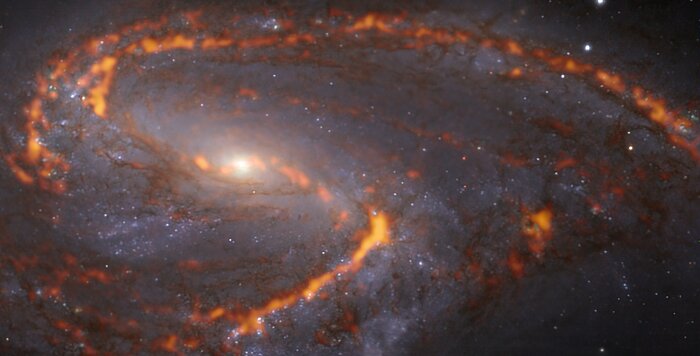A flame thrower
The NGC 3627 galaxy, also known as Messier 66, appears to be expelling flames out of its majestic spiral arms in this Picture of the Week. The “fire” actually marks clouds of cold molecular gas, which is the material out of which stars form, and has been captured using the Atacama Large Millimeter/submillimeter Array (ALMA) in Chile, of which ESO is a partner. The bluish regions in the background reveal the pattern of older, already formed stars, imaged by the Multi-Unit Spectroscopic Explorer (MUSE) on ESO’s Very Large Telescope (VLT) also in Chile.
Located approximately 31 million light-years from Earth in the constellation Leo, NGC 3627 is one of the many galaxies observed as part of the Physics at High Angular resolution in Nearby GalaxieS (PHANGS) project. PHANGS is making high-resolution observations of nearby galaxies with telescopes operating across all colours or wavelengths of the electromagnetic spectrum. Different wavelengths can reveal a multitude of secrets about a galaxy, and by comparing them astronomers are able to study what triggers, boosts or hinders the birth of new stars.
Źródło:ESO/PHANGS
O zdjęciu
| Identyfikator: | potw2250a |
| Typ: | Obserwacje |
| Data publikacji: | 12 grudnia 2022 06:00 |
| Rozmiar: | 1177 x 599 px |
O obiekcie
| Nazwa: | M 66, Messier 66, NGC 3627 |
| Typ: | Local Universe : Galaxy : Type : Spiral |
| Odległość: | 30 milion lat świetlnych |
| Constellation: | Leo |
| Kategoria: | Galaxies |
Współrzędne
| Pozycja (RA): | 11 20 15.33 |
| Pozycja (Dec): | 12° 58' 52.83" |
| Pole widzenia: | 3.92 x 2.00 arcminutes |
| Orientacja: | North is 89.9° lewo of vertical |
Kolory i filtry
| Pasmo | Długość fali | Teleskop |
|---|---|---|
| Optyczny G | 475 nm | Very Large Telescope MUSE |
| Optyczny R | 625 nm | Very Large Telescope MUSE |
| Milimetrowy CO [2–1] | 1.2 μm | Atacama Large Millimeter/submillimeter Array Band 6 |
| Optyczny I | 775 nm | Very Large Telescope MUSE |

